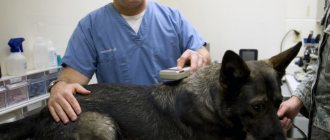Many pet owners still have no idea what a dog chip is, even though pet tagging is becoming increasingly popular. This way you can increase their level of safety, and this method is used not only for purebred breeds. The chip gives additional hope when searching for a lost pet, but it is worth remembering that you can never be 100% sure of success. Therefore, it is necessary to do everything possible to reduce the likelihood of your dog escaping or going missing.
What is a chip and microchipping?
Microchipping a dog is not complicated or painful—don't worry about it being traumatic for your pet. The procedure involves implanting a microprocessor into the body. It doesn't sound like much, but there is nothing to worry about since this minor operation is 100% safe for the animal.
The electronic chip has a fifteen-digit identification code, which will be assigned to your dog. Of course, each such number is unique. In addition, the device must comply with current regulations and standards.
The procedure for microchipping a dog is similar to giving an injection. In the vast majority of cases, the microprocessor is placed between the shoulder blades or on the pet's neck. It is worth emphasizing that implantation occurs only once in a lifetime : due to the lack of an expiration date, there is no need to repeat this process. The chip will work as long as your four-legged friend will live.
This is an excellent option not only for expensive purebred dogs; the owner of any dog must bear full responsibility for the safety of his pet.
Necessity of the procedure
An electronic chip for dogs has been mandatory for visiting EU countries since 2010. This is a real requirement for allowing four-legged animals to cross the border, and is intended to prevent the import of infected animals. In addition, implantation will not allow replacement of representatives of elite breeds. The owner or breeder can easily recognize the dog and lay claim to it.
To participate in competitions and championships at the international level, it is necessary to have an implanted microcircuit with the pet’s data. Implantation is also recommended for hunting animals, which often get lost during long walks with their owners.
There is no law in our country that forces or obliges owners and breeders to insert an electronic chip into their dog. However, there are amendments regarding the need to identify and register pets. This means that microchipping of dogs in Russia may soon become mandatory.
How does a dog chip work?
The chips implanted in animals operate on the basis of radio waves, which ensures high efficiency. It is worth noting that they do not have any power source. The identification code can only be read using a special device - most veterinarians have one. The number is checked in the database and this is how the owner of the missing dog is found.
Microchipping your pet always makes sense when there is a risk of theft and you want to minimize it. You should also be aware that the lack of an identification number may result in the dog being placed in a shelter. Many owners have never managed to find a runaway dog - microchipping greatly increases your chances.
How is chipping carried out?
Chip implantation is a simple surgical procedure similar to vaccination. The entire procedure takes only a few minutes, and the implantation process itself takes a couple of seconds.
Before the procedure, as well as after it, the doctor scans the chip to ensure its functionality. Then, under the skin of the animal, in the area under the withers, an injection is made with a special disposable syringe. The contents of the syringe are a solution to facilitate administration and the chip itself.
Measuring approximately 2 by 12 mm or 1.4 by 8.5 mm (slightly larger than a grain of rice), the microchip is enclosed in a bioglass capsule. This type of glass is absolutely harmless and compatible with the tissues of a living organism. Within a week after the procedure, the biocapsule is surrounded by living tissue and becomes motionless and imperceptible to the animal.
After the injection, the implanted chip is scanned again. The original electronic chip number consists of 15 digits, which encrypt the country code or manufacturer code. The clinic where the procedure was performed enters the information into the database. In Russia at the moment the two largest databases are: www.animal-id.ru and animalface.ru. They are part of international systems. Animal-ID is in Petmaxx, and AnimalFace is in Petmaxx and EuroPetNet.
A sticker with a barcode is pasted into the veterinary passport and pedigree of the dog. It is not recommended to wash the animal for 2 days after the procedure.
Microchipping of dogs is carried out once in the life of the pet. In just a few minutes, the four-legged animal becomes the owner of an electronic number, which is assigned to it once and for all.
How to register a dog chip
Not everyone knows how and where to register a dog identification number - this is not a difficult task. The code must be entered into the database, because only then will it serve its purpose and be able to help identify the dog. It is worth noting that there are several databases - national, international - and they may differ from each other. It is impossible to say exactly where is the best place to register - this is a very individual question.
This is a serious obstacle, especially for a person who is trying to identify the owner of a found dog. You need to check the number in several different databases, and you can never be sure that the owner will eventually be found.
If the dog has changed ownership and moved to a new home, it is important to update personal information in the database. The previous owner may not know where the new owner lives.
Description and characteristics of the transponder
A transponder is a microscopic device that contains a unique animal code.
The size of the transponder used for microchipping dogs and other pets is 13 mm in length and 2 mm in diameter. The tiny device does not interfere with the pet’s life and does not cause discomfort when moving or at rest. The device consists of:
- receiver;
- transmitter;
- multi-turn antenna;
- a memory block with a capacity of at least 96 bits;
- protective capsule made of biologically inert glass.
The microchip is programmed when released by the manufacturing company. A 15-digit code is entered into the transponder memory. The first three digits are the country code corresponding to the ISO 3166 standard. For example, Russia is assigned the code 643, Ukraine - 804, etc. The next 4 characters are the code of the company that issued the microchip. This is followed by 8 digits - an individual code that cannot be changed.
A large number of options for combinations of numbers excludes selection. The code is entered into the Unified National Database, which contains comprehensive information about the dog - name, breed, age, color, contact numbers of the owner and address of his residence. The transponder implanted in the dog fully complies with the ISO standard, which allows you to read the code in any country if you have a scanner.
The transponder coverage area for small pets is 12-20 mm - this is the distance to which the scanner must be brought to read the code. Microchip type – Read only (RO). This device does not require changes to the code, therefore it is used in marking pets.
In addition to the transponder, the kit includes a disposable special syringe with which the device is inserted under the dog’s skin and an ampoule with liquid that facilitates the insertion and assimilation of the chip. Transponders are supplied to Russia, Ukraine, and Belarus by the German company Bayer AG.
How much does a dog chip cost?
Not everyone can afford the large additional costs of a pet, so the price of microchipping is a concern for many. The first step is to find a veterinarian who offers these services. The exact cost depends on the price list of the clinic or private doctor - it is impossible to predict exactly, but estimate approximately 1000–3000 rubles. Of course, the professionalism and qualifications of the doctor are of great importance. Choose a veterinarian who follows all standards and has all the necessary licenses and permits.
Entering an identification number into the database is usually also paid - up to 1000 rubles. This is a one-time fee - you won't have to pay it again. If you want data to be stored in several databases, you will have to pay several times. But sometimes chip registration is already included in the price offered by the veterinarian.
It is also worth remembering about free databases - they are not very popular, but it is better to register there too.
Question answer
If my pet has a microchip, is a tag required?
A token helps find the owner faster than a chip if it contains a phone number. Any person who finds a dog can call it and inform the owner that the loss has been found.
There are two disadvantages - dogs often lose tags while walking. Also, it, along with the collar, can be stolen by removing it from the pet, leaving her to wander further.
Is it possible to detect a chip without a scanner?
The chip can be found using a contrast X-ray or ultrasound, but to read the information you need a scanner.
Can a chip track a dog?
The chip improves your pet's safety, but you should know that it does not work as a GPS module. This means you won't be able to track your pet's location in real time. Only the person who found it would be able to read the ID number—at a veterinary clinic, for example—and then try to look it up in the database. In this way, the finder will be able to obtain information about the dog’s owner and contact him.
Not everyone knows that there are also GPS collars on sale, thanks to which you can monitor your pet’s movements. However, they are not always reliable, so choose carefully.
How data is read from a microchip
Some are worried that the chip contains personal information about the dog and its owner. There is nothing like that, there is just a numerical identification code consisting of 15 digits. This number will not be repeated for a hundred years, therefore it is considered unique. The number cannot be changed in any way; counterfeiting of an already implanted chip is impossible.
The information that the specialist submits to the registry includes general information about who owns the dog and information about it. A scanner is required to read the information. An autonomous device counts an individual number, and devices that can connect to a common database count everything that is recorded in it about a specific dog.
global $ads_google; //data-ad-slot=”2475549904″ $ads_google = empty($ads_google) ? false : true; ?> if ($ads_google == false) {?>
$ads_google = true; ?> } ?>
The microchip code is not a simple random set of numbers. They are the ones used to identify the dog when accessing the database:
- The first 3 digits indicate the country where the chip was manufactured (RF -643);
- The second 4 digits are the chip manufacturer;
- The following numbers encrypt information about the name, color, breed, vaccinations, name of the owner and his contacts.
The code may contain region information. The owner can also offer to add a photo of the pet with its pedigree to the list of information.
Is it possible to change owner details
Do not forget to update the data in the database if you received a pet already with a chip - you must enter new information about the owner. Otherwise, they won’t be able to find you if the need arises. Fortunately, this does not require any special formalities, so no serious problems should arise.
If you sell or give away a chipped dog, you must also ensure that your contact details are no longer visible in the database. No re-registration is required, so you don't have to worry about additional costs.
What information is contained in the chip code?
There is no clear list of information contained on the transponder. This is due to the fact that chips have been installed for more than 20 years, and technology is constantly being improved, which affects how much it costs to chip a dog. Most often, the built-in chip contains the following data:
- The first three digits from the chip code are the designation of the country in which the dog is registered. In Russia it is 643.
- The four further digits indicate which manufacturer made the chip.
- The next eight numbers are information about the dog and its owner.
The last numbers of the code encrypt the color of the animal, its official passport name, and breed. There is also data on the vaccines that the animal received. The transponder also contains information about the pet’s owner and his contact information in case the dog gets lost.
Does the chip cause pain?
There is an opinion that microchipping is used only for purebred dogs, but this is not true. Due to its reasonable cost, the service is available to many. As for the pain associated with implanting a chip under the skin, it is comparable to the sensations from a regular injection. Of course, the procedure cannot be called pleasant, but it also does not cause much suffering.
The procedure takes up to several minutes - then the discomfort goes away. It is worth noting that this is much less painful than branding. Most often, a microprocessor is inserted under the skin during puppyhood, but nothing prevents a microchip from being inserted into an adult dog. Local anesthesia is usually used.
Complications after chipping
The British Small Animal Veterinary Association (BSAVA) is collecting data on adverse reactions to microchips. Since the creation of the database (1996), out of 4 million animals, complications have been detected in 391 pets. The most common problem was migration of the microchip from the original implantation site. Other complications were reported much less frequently.
Among them:
- microchip failure;
- hair loss;
- inflammation at the injection site;
- swelling and tumor formation.
4 cases of oncology were recorded, but according to the collected data, in 2 pets cancer was definitely not associated with microchipping.
Is it necessary to microchip a dog?
Microchipping a dog is not mandatory, but the procedure is useful for everyone who has a pet. This is not too expensive and not problematic, and there is a high probability that if the dog is lost, microchipping will play a decisive role. Failure to trace the owner could result in your pet being repossessed—common for purebred dogs—or returned to the shelter.
Of course, the chip cannot 100% guarantee the return of the pet, because it does not work as a GPS module and everything ultimately depends on the person who found the dog. However, microchipping increases the likelihood of success.
In addition, you should remember that a chip may be needed if you are planning a trip abroad with your pet. To obtain a passport, an animal requires an identification number. And here there are two options: either a chip implanted under the skin, or a traditional mark (tattoo). The latter cannot be called a more humane method, since branding is a more painful procedure than microchipping.
Common misconceptions about microchipping
Since this method was developed relatively recently, owners of four-legged friends are often prejudiced about the procedure. The following is an explanation of frequently asked concerns among owners.
Table 1. Answers to frequently asked questions about chipping
| Question | Answer |
| How long does the chip last? | The device is not supplied with batteries and has no expiration date. It provides lifetime electronic identification. |
| Does the chip produce harmful radiation? | The capsule is energetically passive. The chip is activated under the influence of a minimal electromagnetic field produced by the scanner. |
| Is it possible to implant a new chip when replacing an animal? | To implant a new chip, you must remove the old one. This procedure involves an operation that leaves scars on the animal's body. Subsequently, this is fraught with the exclusion of show breed dogs from the competition program. In addition, a certified veterinarian has no right to carry out such manipulation. |
| Is microchip migration safe? | There is currently no information about a possible threat to the pet's life during chip migration. The use of bioglass and the small size of the device reduce the risk of complications to a minimum. |
| How does migration affect chip readout? | Migration affects the reading time, but not its quality. |
Microchipping is a modern and convenient way to identify pets. Having existed for more than 20 years, it has proven its effectiveness and has become alongside such mandatory procedures as vaccinations against distemper or rabies.
Is a dog chip safe?
The chips that veterinarians implant in dogs comply with a number of regulations and standards. Therefore, you can be completely sure that it is absolutely safe for your pet. In addition, the procedure is extremely simple - you do not have to worry about complications and side effects. It should be emphasized that the microprocessor does not affect health and well-being in any way.
An undoubted advantage is that the chip is invisible to the animal. A person petting a dog may feel a small bump—especially if the dog is a smooth-haired or short-haired breed. It happens that the microprocessor is slightly misaligned, but this is not dangerous and does not affect operation.
The material was prepared by specialists from the veterinary clinic of Daria Sukhova.
The procedure for microchipping pets is available at the veterinary clinic of Daria Sukhova, call +7 (3452) 66-21-29 or come to our veterinary clinic immediately.
Misconceptions and important facts
Although there are many benefits to microchipping your dog, there are persistent prejudices and misconceptions. For example, most owners believe that an inserted capsule with information will make it possible to track a missing animal via satellite. Only a GPS tracker has this function, which can be placed on a collar - but not in the animal’s body.
Other facts you need to know before going to the veterinary clinic:
- The procedure will only be painless if it is performed by an experienced veterinarian. Sometimes the doctor simply pierces the top layer of skin with a needle, and the capsule may subsequently fall out and get lost. This sometimes happens with long-haired breeds.
- The biocompatible material of the reservoir causes allergies in a small percentage of four-legged animals. This manifests itself in inflammation and the formation of pus at the puncture site.
- The shelf life of the microcircuit is not limited, but before the trip it is worth checking the properties using a scanner at the veterinary clinic. This will avoid an unpleasant situation while crossing the border. One of the causes of failure is demagnetization.
The effectiveness of using data chips has been proven by many years of experience in different European countries. An international information base, the presence of scanners in clinics, shelters, nurseries, and the use of reading devices by catching services and customs officers at the border with other countries help to quickly identify and return a lost four-legged animal to its owner. In our country, this multi-stage system is just beginning to develop.











